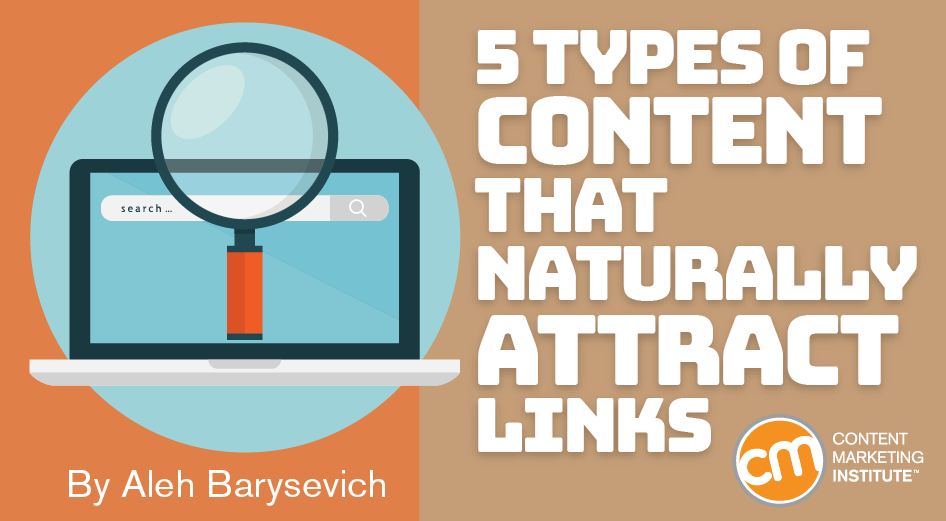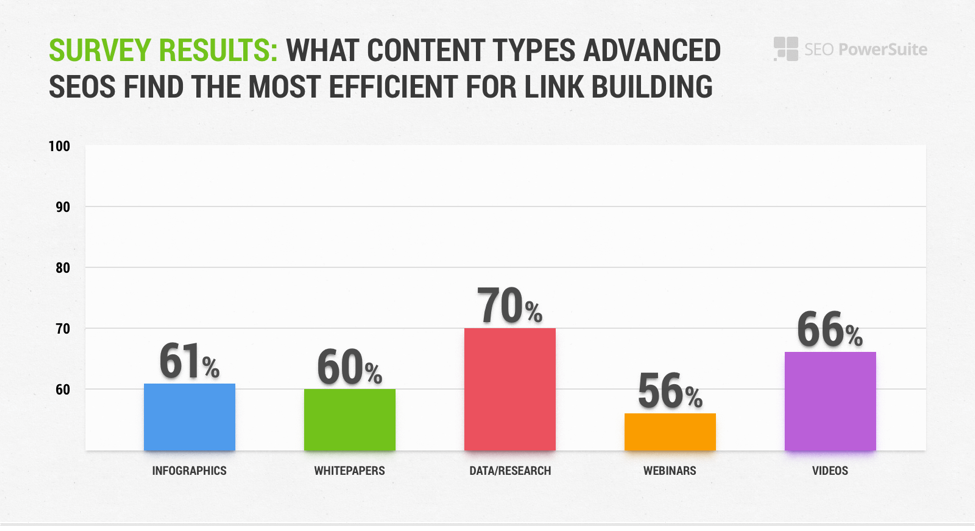Author: Aleh Barysevich / Source: Content Marketing Institute

Practically everyone understands the importance of “doing content marketing,” but many – even those with documented content marketing strategies – don’t know how to align the types of content they create with their desired content marketing goals.
For example, some of the best content for drawing in and nurturing qualified leads – like webinars – underperforms when it comes to link building. By contrast, publishing new data and research is a great way to build a robust link profile.
Those are a few of the new findings from my team’s new Link Building Survey, in which we polled 628 SEO experts across various types of businesses to understand better how they build links for better SEO in 2017. What follows are the five types of content these experts say are best at growing their own links.

1. Infographics
Infographics are one of the most popular types of link-building content. Over half (53%) of the SEO experts create cornerstone infographics and 61% of those find them to be an efficient means of earning backlinks.
Jubaer Prodhan, SEO specialist at Vendasta Technologies, found unprecedented success by creating infographics and then allowing other sites to post them along with content that linked to his company’s site. He explains:
In our outreach efforts, we’ve tried with data, video, infographics (with embed code) and many other things. It worked well, but when we tried data and stats in infographics and reaching out to share the infographics with our personalized custom description for each website, the response and success rate just exceeds all of our past results and expectation.
As soon as Jubaer began distributing these infographics as “guesto-graphics,” content ROI increased dramatically – earning hundreds of backlinks from dozens of different domains. One of his infographics has received nearly 1,000 backlinks from over 300 referring domains.
How to use infographics to build links
Creating link-winning infographics is typically a three-step process:
- Pick a topic highly relevant to your target audience and make it as specific as possible (e.g., if your niche is social media, focus on a single platform that’s hot).
- Gather data points (preferably plucked from original research) about your topic. Wireframe your data points to flow logically down the page.
- Make it look great. Use large fonts and visually represent all key stats so they jump off the page.
TIP: When designing an infographic, you can use free tools like Canva but you may want to hire a designer (or use an in-house designer) for a more customized, professional look.
Once you’ve created your infographic, you need to decide how to distribute it. If you want to create guesto-graphics, like Jabaer, do some cold outreach to key influencers. Offer to let them post your infographic and write a short accompanying guest post for them to publish.
NOTE: The supporting content is key to earning high-quality backlinks because Google devalues earned “embed links” if only your infographic is published.
Alternatively, if you have a large following, publish the infographic on your website and promote it via social media. If your content is highly relevant to other influencers, you’ll likely earn a number of shares, “likes,” and backlinks.
In either case, the quality of the data and the topic’s relevance play a large role in how effectively your infographic earns backlinks.
2. White papers
To build a high-quality link network, you need to start with something worth linking to. That means creating great cornerstone content – content that’s so rich you can repurpose it and use it to engage customers throughout your sales funnel and to encourage a variety of actions.
White papers are among the best types of cornerstone content. These robust resources provide your audience with an in-depth examination of topics that really matter to them. They deliver a potent one-two punch of content that both builds your credibility and solves customer pain points.
Forty-two percent of the responding SEO experts have created white papers and 60% of those find them to be ideal content for earning links. However, as with infographics, content quality is key.
As Camelia Clarke, SEO specialist at GIE Media Inc., explains:
Our best way to create a high link profile for our websites is simply by creating great, unique content. Our sites are B2B and informational, so our internal editors post a lot of content to help our readers succeed in their business, articles that cover unique information and are worthy of being shared. Great content is the most natural way to earn links.
We also link internally to older articles if they offer added value for our readers or more information on the topic they are interested in, so we always keep in mind the importance of internal linking. This also helps us with user/reader engagement.
How to use white papers to build links
You need to hire a copywriter or have some serious writing chops (and a lot of time) to create a white paper worth linking to. Above all else, you should:
- Pick a topic that appeals to your audience and satisfies a pressing need. (Yes, this is Step 1 for every type of content).
- Don’t go overboard on branding. A white paper is not a brochure to advertise your business; it is a resource meant to solve a problem.
- Endeavor to inform and convince your readers. Present information logically and objectively. Your arguments should flow toward your concluding argument. Claims should be well supported and sourced.
- Include visual aids. Remember that graphs and charts are content too.
- Revise until it’s perfect. The editing process is more important than ever in long-form content like this. Fix wordiness, spelling mistakes, and any meandering thoughts.
Fortunately, white papers and e-books are some of those valuable pieces of content that practically sell themselves. If you truly hit on an important need facing your audience, people are all too happy to…
Audience Team
The digital audience insights you need to build, manage and market to your digital audiences.

